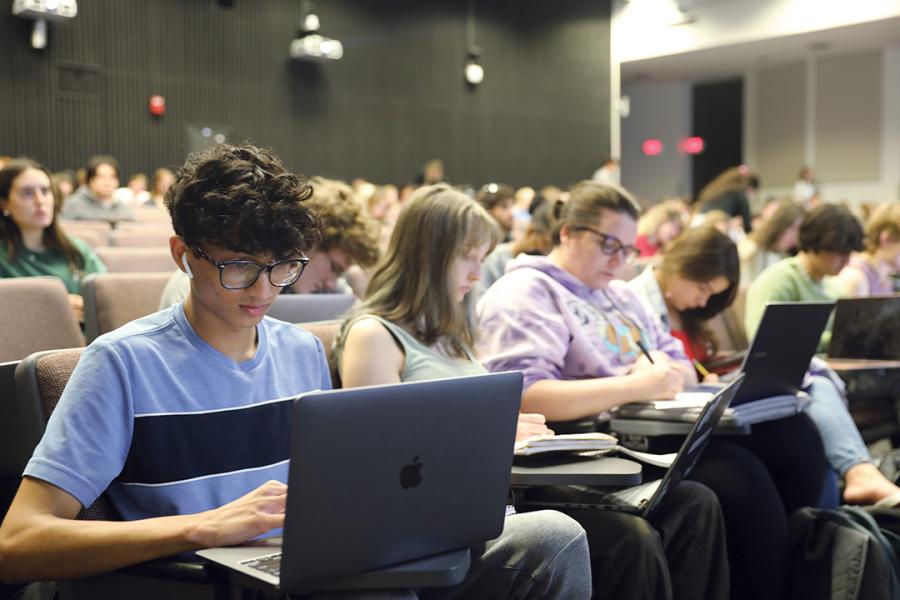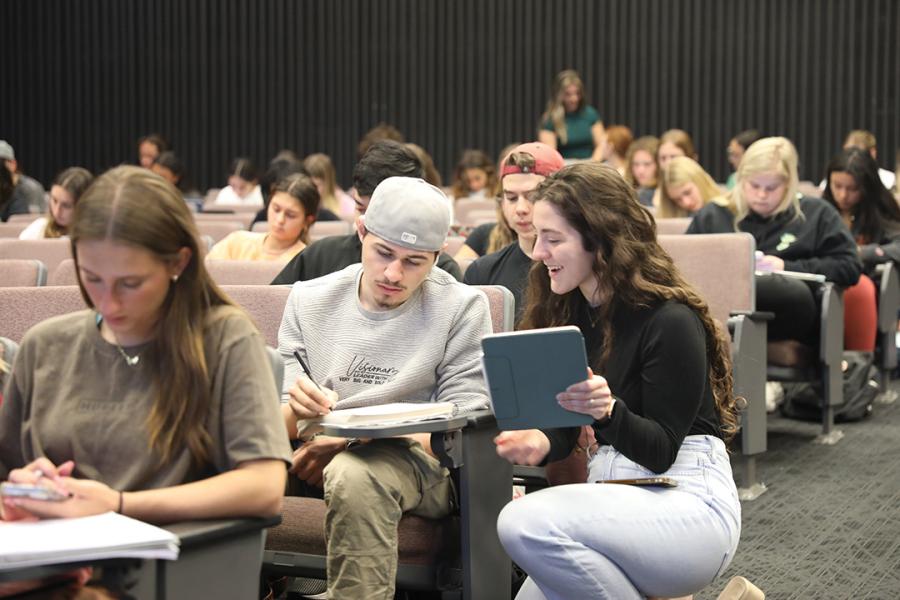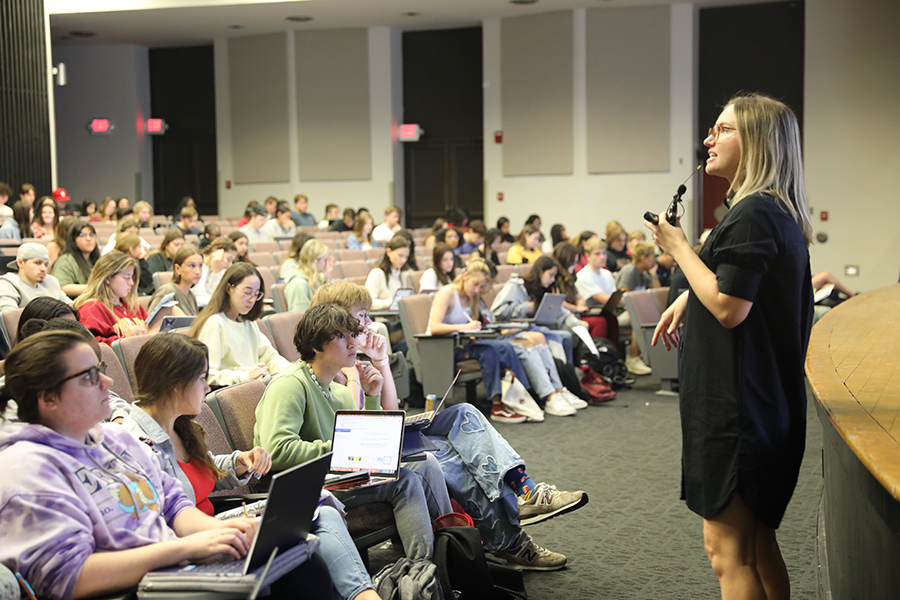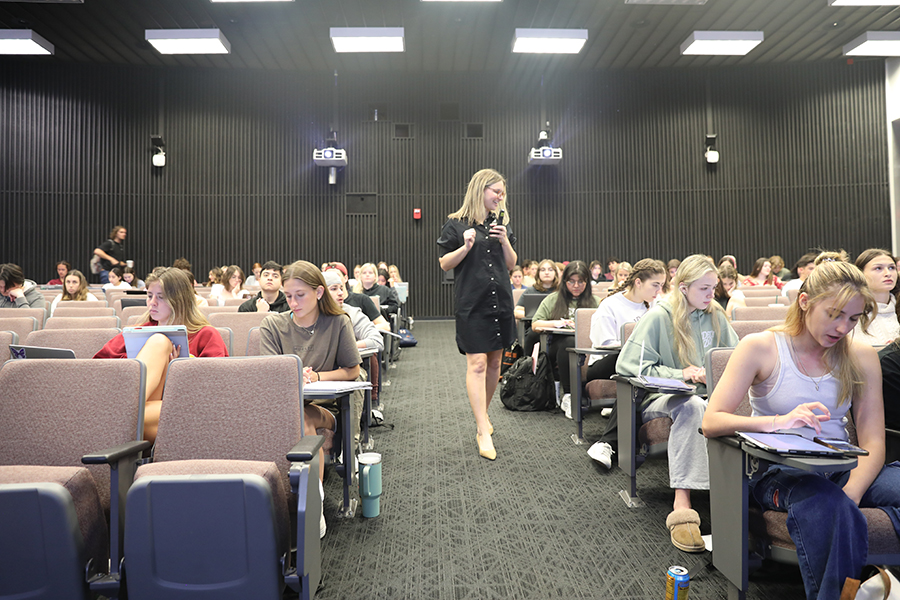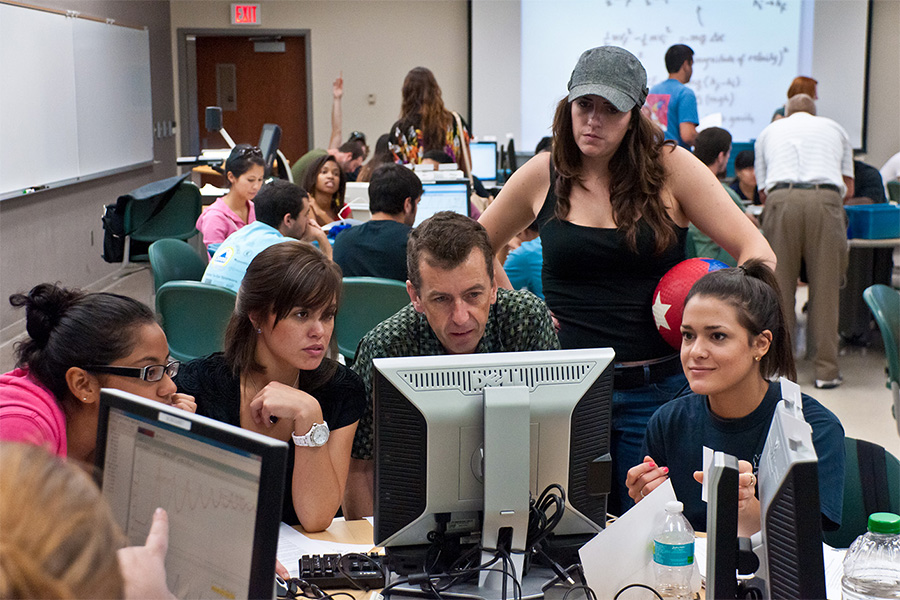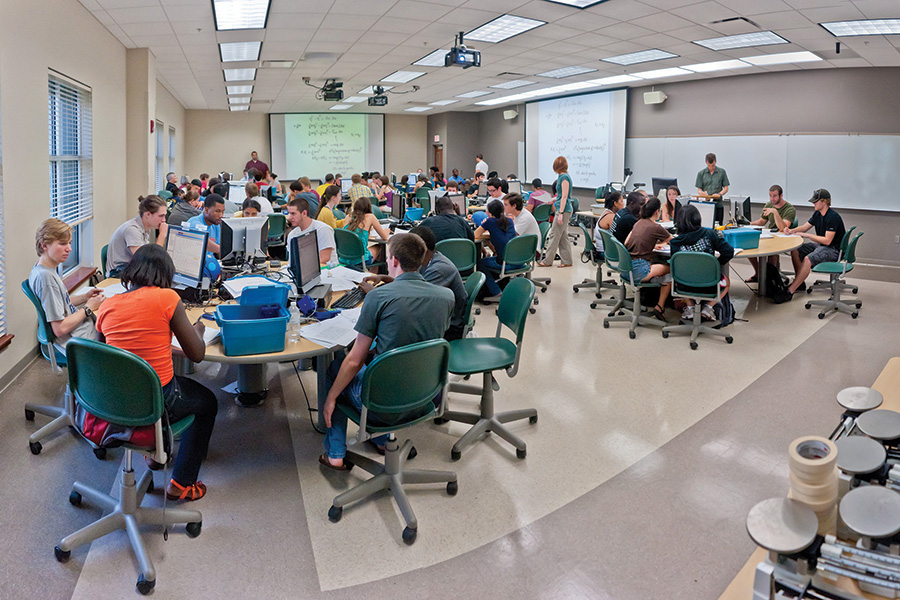
Students participate in a class in the FSU Department of Physics’ Studio Physics Program. Courtesy photo.
It’s a near universal experience: You’re having one of those nightmares where you showed up to class and find out you have a presentation or exam for which you’re completely unprepared. Cue the panic and cold sweat. Then comes the sweet relief of waking up and realizing it was just a dream.
Like those dreams, the shift to college — especially as an undergraduate — can feel overwhelming, but Florida State University is reducing some of that anxiety for students and improving learning outcomes through the use of innovative teaching techniques and collaboration with FSU’s Center for the Advancement of Teaching.
The overarching goal is to improve success in what are known as “gateway courses,” the large introductory classes where students first encounter STEM disciplines at the college level. Students arrive at FSU with a wide range of academic experiences and varying proficiency levels in STEM, but most must begin with these foundational courses. The process for making gateway courses suitable for a mix of students includes structuring an environment around the best ways to deliver information so students connect with the material, internalize it, and can demonstrate what they’ve learned, similar to methods used in the art and design fields.
“CAT started in 2017 and we’re here to support faculty on their course design and anything pertaining to teaching,” said CAT director Leslie Richardson. “The purpose of the center is to curate and interpret research for faculty about how students learn best and offer syntheses and practical applications of that. We work with faculty on making their classroom practice refreshed, but also structured by what we now know about learning.”
Assistant teaching professor Brittany Kraft first learned about CAT while leading General Biology for Non-Majors, the largest lecture course on campus, where some sections include upwards of 600 students.
“How do we make a class that big engaging for students and make it feel personable?” Kraft asked. “I attended a meeting CAT organized with faculty from all over campus and got to talk to people outside my department who also taught large lecture courses. There was a wonderful sense of community, and everyone was encouraging.”
Through the partnership with CAT, professors across biology, chemistry, mathematics, and other departments have been rearranging gateway courses over the past five years from traditional lecture-style format to an evidence-based active learning structure that includes strategies like small-group work and interactive lessons.
“Now it’s a lively atmosphere where the students and I are working as a team to help them learn and it’s a lot less of me being the ‘sage on the stage,’ lecturing to them and hoping they absorb the information. It involves a lot more feedback and give-and-take,” Kraft said.
CAT also introduced the Learning Assistant Program, giving undergraduates who have successfully completed a course the opportunity to work alongside faculty in the classroom, facilitating discussion and helping students navigate course material. Morgan Knipp, a Spring 2024 biochemistry graduate with her sights now set on becoming a certified physician associate, applied to become a Learning Assistant during her sophomore year.
“I was greatly inspired by the LAs who mentored me as a freshman in courses such as biological science and general chemistry,” Knipp said. “They helped me shift smoothly into the rigors of collegiate academics and offered insight on everything from faculty recommendations to ways to get involved. I knew I wanted the opportunity to aid and mentor other students as my LAs had done for me.”
Knipp adds that the LAs also serve as a bridge between professors and students, moving throughout the classroom during in-class exercises to assist and answer questions.
“The LA Program encourages collaborative learning, gives students more points of contact in difficult courses, and cultivates a learning environment that is adaptive, inquisitive and effective,” Knipp said.
Associate professor of chemistry Ken Hanson began noticing positive changes among his students when shifting away from “plug-and-chug” math to an active learning format. Rather than simply memorizing information, they were learning the “why” and were able to apply the knowledge gained as concepts advanced throughout the semester. The result is stronger test performance and improved readiness for the next courses in students’ programs of study.
“Students are much more engaged; they’re excited to show up. A groan when they get a question wrong is exciting for us because they’re genuinely invested in the question,” Hanson said.
Chemistry teaching faculty Bridget DePrince said that modifications to the way faculty communicate expectations and milestones with students have been instrumental to progress and created consistency across sections of the same course taught by multiple faculty members.
“One of the biggest things we’ve done is formally articulating learning goals for the students with a clearer eye of what we’re asking them to be able to do, or show they know, and why,” DePrince said.
In the Department of Mathematics, professor Alec Kercheval has worked alongside CAT and the department’s Basic Math Group on setting goals to introduce teaching methods in the classroom that are based on nationwide educational research conducted over the last two decades. In 2018, the department put strategies in motion to address high DFW rates — drops, D and F grades, and withdrawals — among students in trigonometry.
“We started some workshops and a close working relationship between CAT and the mathematics faculty teaching the general education courses. It has been extremely valuable,” Kercheval said. “The goal has been to bring back into the basic mathematics teaching practice a kind of collaborative point of view, where faculty could support each other, and to bring more modern ideas surrounding how students learn in the classroom, which includes a lot of active learning.”
Over the last six years, the mathematics department has hired five new faculty in the Basic Math Group, several of whom hold doctorates in math education. DFW rates in two of the more challenging courses — trigonometry and college algebra — have plunged from 40 percent to 10 percent and from 17 percent to 11 percent, respectively.
“I get a lot of feedback from students in my course evaluations about how they wish we could do even more of these activities in class because it really helps them retain the information,” said mathematics teaching faculty Leah Hollingsworth.
The positive response from students has also been echoed in CAT’s “Thank a Professor” notes students can opt to send faculty at the end of the year.
“One of the notes actually made me cry,” Richardson said. “It read, ‘I was thinking about dropping out of college because I was doing badly in my basic math class and felt like a failure. I went to see Dr. Hollingsworth and she was so kind and supportive. She convinced me I could do it and that she had designed this class to ensure I was going to learn and succeed. She wanted me to stick with it, so I did. I recovered and stayed in college.’ I get choked up, but it’s not unusual for these faculty to receive such notes.”
Before CAT was established, the Department of Physics had pioneered its own strategy for improving student success through the Studio Physics Program, which launched in 2008 and implements an interactive style of class based on research from North Carolina State University on the SCALE-UP model — Student-Centered Active Learning Environment for Undergraduate Programs.
“The Studio Physics Program is a way of teaching introductory physics to students that recognizes students learn best when they’re learning together and having discussions with each other and with us, the instructors,” said professor of physics Paul Cottle. “The program has been very successful at improving student learning gains.”
Today, approximately 200 students take Studio Physics classes each semester, which include classroom spaces designed to promote small-group interactions during class activities. Physics professors teaching the lecture courses have also adopted elements of the program, Cottle added, in essence reaching every FSU student taking a physics course.
For students like Morgan Knipp, succeeding in foundational STEM courses is not only about laying the groundwork for a more positive college experience, but ensuring success in their chosen major and future career.
“My time as an undergraduate student in STEM core courses completely reshaped the way I think about the world around me,” Knipp said. “I honed my ability to think critically and apply my acquired knowledge to real-world situations. These classes have instilled an inquisitive and methodical nature in myself and my peers. I am confident we will all emerge from FSU with an even deeper passion for understanding the world around us.”
Assistant teaching professor Brittany Kraft first learned about CAT while leading General Biology for Non-Majors, the largest lecture course on campus, where some sections include upwards of 600 students.
“How do we make a class that big engaging for students and make it feel personable?” Kraft asked. “I attended a meeting CAT organized with faculty from all over campus and got to talk to people outside my department who also taught large lecture courses. There was a wonderful sense of community, and everyone was encouraging.”
Through the partnership with CAT, professors across biology, chemistry, mathematics, and other departments have been rearranging gateway courses over the past five years from traditional lecture-style format to an evidence-based active learning structure that includes strategies like small-group work and interactive lessons.
“Now it’s a lively atmosphere where the students and I are working as a team to help them learn and it’s a lot less of me being the ‘sage on the stage,’ lecturing to them and hoping they absorb the information. It involves a lot more feedback and give-and-take,” Kraft said.
CAT also introduced the Learning Assistant Program, giving undergraduates who have successfully completed a course the opportunity to work alongside faculty in the classroom, facilitating discussion and helping students navigate course material. Morgan Knipp, a Spring 2024 biochemistry graduate with her sights now set on becoming a certified physician associate, applied to become a Learning Assistant during her sophomore year.
“I was greatly inspired by the LAs who mentored me as a freshman in courses such as biological science and general chemistry,” Knipp said. “They helped me shift smoothly into the rigors of collegiate academics and offered insight on everything from faculty recommendations to ways to get involved. I knew I wanted the opportunity to aid and mentor other students as my LAs had done for me.”
Knipp adds that the LAs also serve as a bridge between professors and students, moving throughout the classroom during in-class exercises to assist and answer questions.
“The LA Program encourages collaborative learning, gives students more points of contact in difficult courses, and cultivates a learning environment that is adaptive, inquisitive and effective,” Knipp said.
Associate professor of chemistry Ken Hanson began noticing positive changes among his students when shifting away from “plug-and-chug” math to an active learning format. Rather than simply memorizing information, they were learning the “why” and were able to apply the knowledge gained as concepts advanced throughout the semester. The result is stronger test performance and improved readiness for the next courses in students’ programs of study.
“Students are much more engaged; they’re excited to show up. A groan when they get a question wrong is exciting for us because they’re genuinely invested in the question,” Hanson said.
Chemistry teaching faculty Bridget DePrince said that modifications to the way faculty communicate expectations and milestones with students have been instrumental to progress and created consistency across sections of the same course taught by multiple faculty members.
“Students are much more engaged; they’re excited to show up. A groan when they get a question wrong is exciting for us because they’re genuinely invested in the question.”
Ken Hanson, Associate Professor of Chemistry
“One of the biggest things we’ve done is formally articulating learning goals for the students with a clearer eye of what we’re asking them to be able to do, or show they know, and why,” DePrince said.
In the Department of Mathematics, professor Alec Kercheval has worked alongside CAT and the department’s Basic Math Group on setting goals to introduce teaching methods in the classroom that are based on nationwide educational research conducted over the last two decades. In 2018, the department put strategies in motion to address high DFW rates — drops, D and F grades, and withdrawals — among students in trigonometry.
“We started some workshops and a close working relationship between CAT and the mathematics faculty teaching the general education courses. It has been extremely valuable,” Kercheval said. “The goal has been to bring back into the basic mathematics teaching practice a kind of collaborative point of view, where faculty could support each other, and to bring more modern ideas surrounding how students learn in the classroom, which includes a lot of active learning.”
Over the last six years, the mathematics department has hired five new faculty in the Basic Math Group, several of whom hold doctorates in math education. DFW rates in two of the more challenging courses — trigonometry and college algebra — have plunged from 40 percent to 10 percent and from 17 percent to 11 percent, respectively.
“I get a lot of feedback from students in my course evaluations about how they wish we could do even more of these activities in class because it really helps them retain the information,” said mathematics teaching faculty Leah Hollingsworth.
The positive response from students has also been echoed in CAT’s “Thank a Professor” notes students can opt to send faculty at the end of the year.
“One of the notes actually made me cry,” Richardson said. “It read, ‘I was thinking about dropping out of college because I was doing badly in my basic math class and felt like a failure. I went to see Dr. Hollingsworth and she was so kind and supportive. She convinced me I could do it and that she had designed this class to ensure I was going to learn and succeed. She wanted me to stick with it, so I did. I recovered and stayed in college.’ I get choked up, but it’s not unusual for these faculty to receive such notes.”
Before CAT was established, the Department of Physics had pioneered its own strategy for improving student success through the Studio Physics Program, which launched in 2008 and implements an interactive style of class based on research from North Carolina State University on the SCALE-UP model — Student-Centered Active Learning Environment for Undergraduate Programs.
“The Studio Physics Program is a way of teaching introductory physics to students that recognizes students learn best when they’re learning together and having discussions with each other and with us, the instructors,” said professor of physics Paul Cottle. “The program has been very successful at improving student learning gains.”
Today, approximately 200 students take Studio Physics classes each semester, which include classroom spaces designed to promote small-group interactions during class activities. Physics professors teaching the lecture courses have also adopted elements of the program, Cottle added, in essence reaching every FSU student taking a physics course.
For students like Morgan Knipp, succeeding in foundational STEM courses is not only about laying the groundwork for a more positive college experience, but ensuring success in their chosen major and future career.
“My time as an undergraduate student in STEM core courses completely reshaped the way I think about the world around me,” Knipp said. “I honed my ability to think critically and apply my acquired knowledge to real-world situations. These classes have instilled an inquisitive and methodical nature in myself and my peers. I am confident we will all emerge from FSU with an even deeper passion for understanding the world around us.”





